'Butterfly nebula': Hubble Telescope captures images of two stars, dust in wing formation

NASA's Hubble Space Telescope has released images of a shimmering "cosmic butterfly," or the Twin Jet Nebula, made up of an aging star's exposed core and a smaller star that create an illuminating rainbow in space.
Images of the Twin Jet Nebula, officially known as the PN M2-9, were captured as the nebula's center is slowly collapsing, causing the dying star to shed its outer layers. The larger, dying star is orbited by the small star, or small white dwarf, which pulls those layers in a bipolar pattern, exemplified by the iridescent "wings" of the cosmic butterfly.
Hubble sees jets of gas streaming at speeds in excess of one million kilometers per hour: https://t.co/2ihRy9BReCpic.twitter.com/yk8AJIZHLv
— NASA Goddard Images (@NASAGoddardPix) August 26, 2015As the outer layers fade out, the dying star's core shines, illuminating two giant gas jets moving at more than one million kilometers (621,400 miles) per hour.
Check out SOFIA's infrared view of Butterfly Nebula compared to @NASA_Hubble's visible view http://t.co/qlwkehMBfipic.twitter.com/hFnpPHtUA3
— SOFIAtelescope (@SOFIAtelescope) August 26, 2015"The characteristic shape of the wings of the Twin Jet Nebula is most likely caused by the motion of the two central stars around each other,"NASA said. "It is believed that as the dying star and white dwarf orbit around their common center of mass, the ejected gas from the dying star is pulled into two lobes rather than expanding as a uniform sphere."
Hubble telescope captures cosmic 'fireworks' from barred spiral galaxy http://t.co/YrwCNCmtbNpic.twitter.com/loVTSVqNXK
— RT (@RT_com) August 17, 2015Researchers say the nebula was created about 1,200 years ago, according to NASA. The nebula's wings are expected to grow as the stars continue spinning around one another at a pace of once every 100 years.
"This rotation not only creates the wings of the butterfly and the two jets, it also allows the white dwarf to strip gas from its larger companion, which then forms a large disc of material around the stars, extending out as far as 15 times the orbit of Pluto!" NASA reported.
The Hubble Telescope is operated by NASA and the European Space Agency. Hubble began its mission in 1990, providing unparalleled perceptions of the cosmos. The telescope has been serviced five times since its launch.
Did you know our @NASA_Hubble telescope has a successor? The @NASAWebbTelescp will see even deeper into the universe
https://t.co/4IT3GmRBR9
— NASA (@NASA) August 27, 2015














